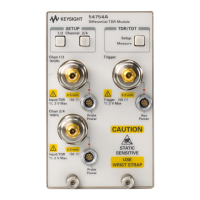Transmission Line Theory Applied to Digital Systems
Microstrip Transmission Line Techniques Evaluated Using TDR Measurements
11-26
The maximum reflection voltage occurs at t = T
1
. Then, for R = Z
o
:
(21)
This equation relates the maximum reflected voltage, which can be measured
by TDR, and the inductance, which can then be calculated for the circuit of
Figure 11-11.
TDR Example 3
This example indicates how to measure the effect of resistor leads using the
TDR. Figure 11-12A shows the construction of a microstrip board used for
determining the effects of a resistor with 1" lead lengths. The reflected voltage
determined from the TDR measurement is 480 mV (see Figure 11-12B). The
risetime at the input to the line is 28 ps but it is lengthened to about 80 ps as
the wavefront reaches the termination resistor.
The time, T
1
, associated with the slope of the input voltage rise at the
terminating resistor can be approximated as:
(22)
The inductance can be computed by using equation 21, giving L = 6 nH.
Additional information can be obtained from the decay of the reflection shown
in Figure 11-12B. The decay lasts about 0.3 ns implying a time constant of about
0.3 ns/5 = 60 ps (using 5 time constants as decay time). The calculated time
constant for an inductance of 6 nH is:
The two results agree closely.
When driving the line with a MECL III gate risetime = 1 ns the reflection would
be only 50 mV. Most carbon resistor types will have less than 10 nH of
inductance. This inductance gives a reflection of less than 75 mV when the line
is driven by a MECL III gate. Note that the reflection is positive, indicating that
the noise immunity of a MECL gate connected at the load would be unchanged.
T
ref
1
tT
1
=
()E
ref
1
max
mL
2
Z
o
---------
1
e
2
Z
o
L
---------
T
1
–
–
==
T
1
t
r
0.80
----------
≈
100
ps
=
L
2
Z
o
---------60
ps
=

